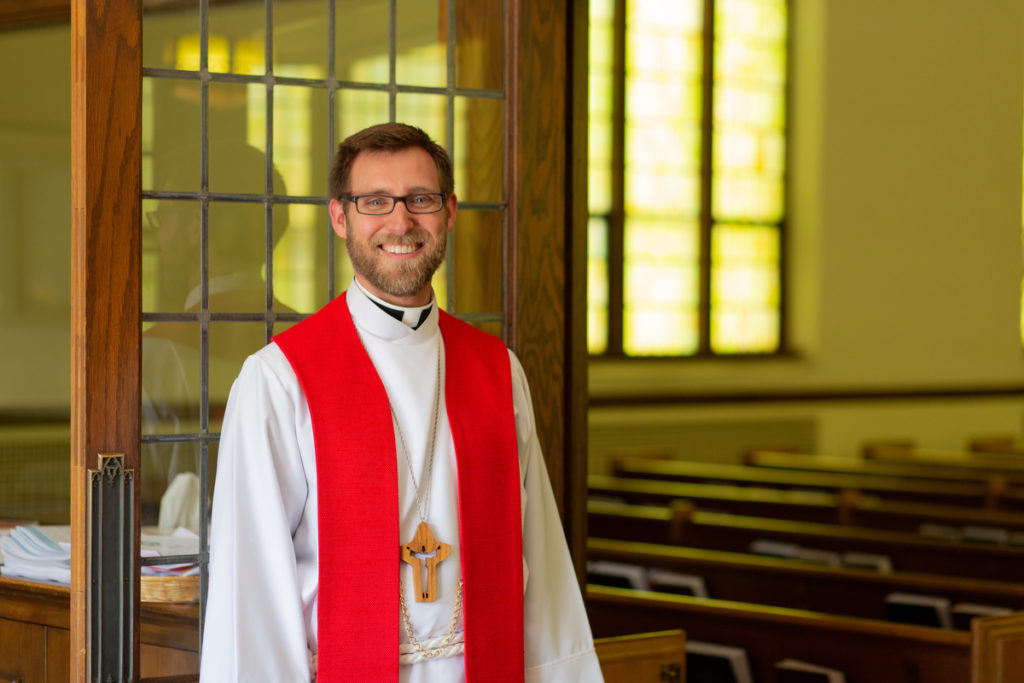In my Summer Letter from the Director I told in great detail the disturbing story of how Bishop Yehiel Curry of the ELCA’s Metropolitan Chicago Synod threatened, intimidated, bullied, and abused power in order to gain control of a CORE-friendly congregation that was doing its best to reach out to its bi-lingual and Spanish speaking neighborhood with the love of Jesus. A link to that letter can be found here. That bishop and synod council used chapter S13.24 in the Model Constitution for Synods as a way to move in and take over the congregation.
I recently become aware of another situation where the synod council of another ELCA synod – Southwest California – used the same constitutional provision to seize the property of a congregation. As a former ALC congregation, according to the ELCA constitution, Faith Lutheran Church of San Dimas, California should have had no problem keeping their property as they voted to disaffiliate from the ELCA and join another Lutheran church body. But that synod council used chapter S13.24 of the Model Constitution for Synods, along with rejecting the legitimacy of LCMC as a recognized Lutheran church body, to claim to have the right to the congregation’s property. My concern has only grown greater as I wonder whether these are two isolated incidents or is this a pattern – an intentional strategy – that we will see continue to unfold throughout the ELCA.
In part the relevant constitutional chapter reads as follows –
S13.24 – The Synod Council, itself or through trustees appointed by it, may take charge and control of the property of a congregation of this synod to hold, manage, and convey the same on behalf of this synod, if. . . .
d. The Synod Council determines that the membership of a congregation has become so scattered or so diminished in numbers that it cannot provide required governance or that it has become impractical for the congregation to fulfill the purposes for which it was organized.
e. The Synod Council determines that it is necessary for this synod to protect and preserve the congregation’s property from waste and deterioration.
The congregation shall have the right to appeal any such decision to the next Synod Assembly.
The way in which Bishop Curry and the Metropolitan Chicago Synod Council used this provision to gain control of a former ALC congregation and its property I described in my Summer Letter from the Director. Here I will tell how the Southwest California Synod Council used the same provision to justify demanding the deed to the property of another former ALC congregation.
Six years ago Faith Lutheran Church in San Dimas, California, was a thriving congregation led by a very gifted, hardworking, faithful, committed, and orthodox pastor. I would say he was one of the best. After his retirement the congregation struggled as it had an extremely difficult time finding another pastor who would be appropriate for them. Attendance and involvement dropped and the preschool had to close during the COVID pandemic. Finally, after two years, they did find a pastor, but that pastor turned out to be a disaster. Later they discovered that that pastor had embezzled funds from a former congregation. (That information was shared as public information during the discussion at the synod assembly.) Attendance dropped even further, many of the positions on the congregation council remained vacant, and the congregation had to request forbearance on the loan for their beautiful new sanctuary.
Needing help with their situation, the congregation entered into a Synodical Administration arrangement with the synod. This arrangement is described in S13.25. of the Model Constitution for Synods, which says, “This synod may temporarily assume administration of a congregation upon its request or with its concurrence. Such synod administration shall continue only so long as necessary to complete the purposes for which it was requested by the congregation or until the congregation withdraws consent to continued administration.” Three local ELCA pastors were assigned to the congregation to help them through their difficult times.
But the real turnaround for the congregation occurred when they invited a non-Lutheran new church start to begin meeting on their property. With the presence of the other congregation and the dynamic, outreach-oriented leadership of the young, evangelical pastor, new energy came to the place. The synod continued to be unable to provide the congregation with a suitable pastor to call – or even a supply pastor or an interim pastor that would be appropriate for them. I understand from a former member of the executive committee of the synod council of that synod, that of the approximately one hundred congregations in that synod, forty-two of them are without a pastor. Because the synod could not provide a pastor, the ELCA congregation asked the young, dynamic, energetic, outreach-oriented pastor of the new, non-Lutheran church start to provide them with pastoral care and leadership. The non-Lutheran pastor would lead the ELCA congregation’s traditional, liturgical service at 9 AM and then the new church start’s contemporary service at 11 AM. The ELCA synodical bishop, seeing how the Lord was blessing the ministry, agreed to the arrangement.
The problem came when the congregation voted to disaffiliate from the ELCA and join LCMC (Lutheran Congregations in Mission for Christ). As a former ALC congregation, they should have had no problem keeping their property. But the synod council accused them of joining LCMC only as a way of getting out of the ELCA with the intent of then joining this non-Lutheran group. The young, dynamic, energetic, outreach-oriented, evangelical pastor of the non-Lutheran church start offered to take courses in Lutheran theology so that he would be better equipped to provide pastoral care and leadership for the Lutheran congregation, and he was also mentored by a retired ELCA pastor, but that was not sufficient. The synod council said that the congregation can leave the ELCA, the congregation and the non-Lutheran new church start can rent the church building from the ELCA, but the congregation must surrender the deed to the property to the synod. The congregation appealed the decision to the synod assembly which is how I became aware. The appeal was decisively denied.
During the discussion at the synod assembly it was revealed that after the congregation voted to disaffiliate from the ELCA, the synod council changed their relationship with the congregation from Synodical Administration (S13.25), which is voluntary and temporary, to Synodical Preservation (S13.24), which is involuntary and permanent. (It is interesting that the president of the congregation said that they did not know that the synod had taken that action and changed the terms of the relationship until six months after the change had been made.)
The synod council used chapter S13.24 of the synod’s constitution to argue that demanding the deed to the property was something they needed to do and had the right to do in order to “protect and preserve the congregation’s property from waste and deterioration.” But the congregation’s property was not in danger of “waste and deterioration.” Energy had returned, attendance was up, the preschool had reopened, the congregation was able to resume payments on the loan, and people were again involved in ministry and willing to serve in positions of leadership. The synod misused this provision in the constitution because they did not like the fact that the congregation was moving in a different direction – and in a direction which was working out better for them. In fact, a pastor who is a member of the executive committee of the synod council argued in front of the assembly that the synod needed to invoke S13.24 and seize the property in order to keep the property “from deterioration into a non-ELCA entity.”
The synod council also argued that LCMC was not really a valid church body, so in joining LCMC the congregation had not met constitutional requirements in order to be able to keep their property. For me one of the most alarming parts of the discussion was when Synodical Bishop Brenda Bos said in her initial presentation that LCMC is “a very, very loosely affiliated Lutheran denomination” and then suggested that “LCMC may have been created for exactly this constitutional clause so that congregations that do not want to be Lutheran anymore can go into that system and keep their property.” During the discussion the member of the executive committee mentioned above quoted from the LCMC website which says, “We’re not a denomination, we’re a movement” and then said about LCMC, “They are imposters.” (It makes me wonder how often the same line of argument has been used or will be used against other former ALC congregations that will vote to leave the ELCA and join LCMC.)
As I watched and listened to the discussion in the You Tube recording of the second day of the synod assembly, there were two images that came to mind. The first is the old proverb, “If the camel once gets his nose in the tent, his whole body will soon follow.” Once the congregation invited the synod to come in and administer the congregation (under S13.25), it was very easy for the synod to remain, take over, and seize the property (under S13.24).
The second are the words near the beginning of the book of Exodus – “Now a new king arose over Egypt, who did not know Joseph” (Exodus 1:8). Bishop Bos of the Southwest California Synod obviously did not know – nor did she bother to find out about – the actual issues that led to the formation of LCMC. It was not to give churches who did not want to be Lutheran anymore a chance to get out of the ELCA and keep their property. Rather the precipitating event was the ELCA’s approving the Called to Common Mission agreement with the Episcopal Church. In that agreement a certain structure – the Episcopal version of the Historic Episcopate – became mandated. The founders of LCMC argued – on the basis of Article Seven of the Augsburg Confession – that “the Church is the congregation of saints, in which the Gospel is rightly taught and the Sacraments are rightly administered.” Therefore, no particular human, governmental structure is necessary in order for the church to be the church. LCMC was formed in 2001. Since then the organization has grown to be an international movement of around one thousand congregations, including around eight hundred congregations here in the United States. Many of those congregations are former ALC congregations who voted to disaffiliate from the ELCA and kept their property as they then affiliated with LCMC. Precedence strongly supports former ALC congregations’ being able to leave the ELCA, join LCMC, and not have any problem keeping their property. As time passes more and more synodical bishops and other ELCA leaders are not going to have been a part of the issues and struggles that led to the formation of LCMC and the NALC. They are simply not going to be aware of them, let alone understand and appreciate them.
But a third thing that completely floored me was when Bishop Bos, at the end of her presentation, called upon the assembly to “deeply consider the legacy of the Lutherans that came before.” During the discussion leading up to the vote which denied the congregation’s appeal, the argument was made that for over sixty years faithful Lutherans had been working and giving to start and support a Lutheran presence and ministry in the city of San Dimas. Therefore, the assembly should not break trust with six decades of faithful Lutherans and allow a schismatic group to now take the property and give it to a non-Lutheran ministry. I was absolutely astounded hearing this line of argument. I realize that the young, dynamic, energetic, outreach-oriented, evangelical pastor of the new church start does not have a sacramental view of baptism and the Lord’s Supper, but I truly believe that his view of the Scriptures, moral values, and the mission of the church is far closer to that of the founders of that congregation than the ELCA is today. And since when does the ELCA care about not breaking trust with faithful Lutherans of the past?
The 2025 ELCA Churchwide Assembly is approaching, when voting members will consider a plan to reconstitute the church, review the 2009 human sexuality social statement, and possibly (probably?) eliminate the provision for bound conscience. Bound conscience is the language that the 2009 human sexuality social statement uses to declare that a variety of views on same sex relationships – including traditional views – do exist within the ELCA and will be viewed as valid, and those who hold them will be treated with honor and respect. I assume the ELCA knows that there may well be another wave of congregations wanting to leave the ELCA, so are they taking steps now to make it as difficult as possible for congregations to leave with their properties? As congregations continue to decline and congregational, synodical, and churchwide income continues to drop, will the ELCA grab as many properties as possible and make it as difficult as they can for congregations (even former ALC congregations) to leave with their property? Please let me know if you know of other examples of this dynamic.
One final thought. The August 2022 ELCA Churchwide Assembly overwhelmingly approved a Land Back Memorial, in which they supported a resolution which called upon the ELCA to “support creative programs of restorative justice in partnership with Indigenous people, including, but not limited to, whenever considering a transfer or sale of real property, including returning land (and any structures built on it) after satisfying any financial obligations, to the appropriate Native nations, and when direct return is not feasible or not desired by the Indigenous people, to return the proceeds from the sale of the land to the ELCA Native American Ministry Fund or other local Indigenous led ministries or organizations.” Will the Southwest California Synod, in order to not be complicit in something that they are so concerned about – the stealing of land from Indigenous people – follow through with and make good their concern and give the newly acquired property – or the value of that property – to Indigenous people?


























